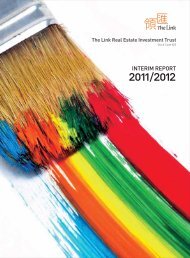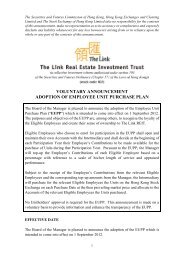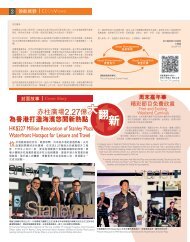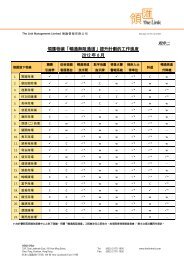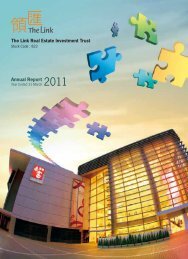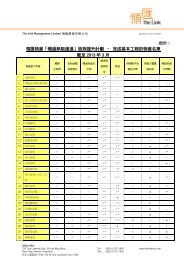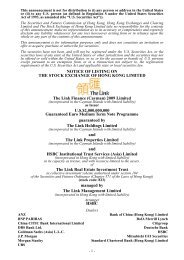Create successful ePaper yourself
Turn your PDF publications into a flip-book with our unique Google optimized e-Paper software.
<strong>Annual</strong> <strong>Report</strong> <strong>2007</strong><br />
<strong>The</strong> <strong>Link</strong> Real Estate Investment Trust<br />
91<br />
Notes to the Consolidated Financial Statements<br />
3 Summary of significant accounting policies (continued)<br />
(q) Derivative financial instruments and hedging activities<br />
A derivative is initially recognised at fair value on the date a derivative contract is entered into and is subsequently<br />
remeasured at its fair value. <strong>The</strong> method of recognising the resulting gain or loss depends on whether the derivative<br />
is designated as a hedging instrument, and if so, the nature of the item being hedged.<br />
<strong>The</strong> Group uses interest rate swaps to hedge its exposure against changes in interest rates. Hedging relationships are<br />
classified as cashflow hedges when such relationships are used to hedge against exposure to variability in cashflows<br />
that are attributable to a particular risk associated with a recognised asset or liability and such variability could affect<br />
profit or loss.<br />
<strong>The</strong> Group documents at the inception of the transaction the relationship between hedging instruments and hedged<br />
items, as well as its risk management objective and strategy for undertaking various hedge transactions. <strong>The</strong> Group<br />
also documents its assessment, both at hedge inception and on an ongoing basis, of whether the derivatives that are<br />
used in hedging transactions have been and will continue to be highly effective in offsetting changes in cashflows<br />
of hedged items.<br />
<strong>The</strong> changes in the fair value of the effective portion of derivatives that are designated and qualify as cash flow hedges<br />
is deferred in a hedging reserve. <strong>The</strong> gain or loss relating to the ineffective portion is recognised immediately in the<br />
income statement.<br />
Amounts accumulated in hedging reserve are transferred to the income statement in the periods when the<br />
hedged item affects earnings. However, when the highly probable forecast transaction that is hedged results in the<br />
recognition of a non-financial asset or a non-financial liability, the gains and losses previously deferred in hedging<br />
reserve are transferred from hedging reserve and included in the measurement of the initial cost or carrying amount<br />
of the asset or liability.<br />
When a hedging instrument expires or is sold or terminated, or when a hedge no longer meets the criteria for<br />
hedge accounting, any cumulative gain or loss existing in hedging reserve at that time remains in hedging reserve<br />
and is recognised when the forecast transaction is ultimately recognised in the income statement. When a forecast<br />
transaction is no longer expected to occur, the cumulative gain or loss that was reported in hedging reserve is<br />
immediately transferred to the income statement.<br />
(r)<br />
Financial risk factors<br />
<strong>The</strong> Group’s activities expose it to a variety of financial risks: price risk, credit risk, interest rate risk, liquidity risk and<br />
insurable risks. <strong>The</strong> Group’s overall risk management programme focuses on the unpredictability of financial markets<br />
and seeks to minimise potential adverse effects on the Group’sfinancial performance.<br />
(i)<br />
Price risk<br />
<strong>The</strong> Group is exposed to property price and market rental risk because investment properties are carried at fair<br />
value. Any change in fair values is recognised in the income statement.



